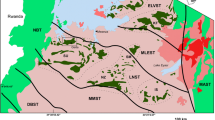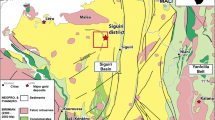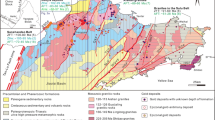Abstract
The Bendigo and Castlemaine goldfields are classic examples of structurally controlled orogenic gold deposits in the Bendigo Zone of central Victoria, SE Australia. Detailed mapping and biostratigraphic interpretation has led to a better understanding of the regional structural controls of this type of gold-quartz mineralisation. Mineralised quartz veins are hosted by the Castlemaine Group, an Early-to-Middle Ordovician turbidite succession at least 3,000 m thick. Gold deposits are controlled by low-displacement faults that are clustered into several belts (the goldfields) indicating a regional structural control. The timing of mineralisation overlapped with that of the major period of deformation including folding, cleavage development and regional faulting. The Bendigo and Castlemaine goldfields are located in an area termed the Whitelaw thrust sheet bounded by two unmineralised, high-displacement, regional-scale faults. Mapping has revealed an interrelationship between the regional-scale faults, regional structural style and goldfield location. The goldfields lie immediately west of the boundary between the upper and lower portions of the thrust sheet and are characterised by symmetric folds with sub-horizontal to synclinal enveloping surfaces, relatively low co-axial strains and moderate cleavage development. The non-gold-bearing areas immediately east of each goldfield correspond with the lower part of the Whitelaw thrust sheet and are characterised by higher non-coaxial strains, stronger cleavage and folds with wide west-dipping limbs giving rise to easterly vergent sections and steeply west-dipping enveloping surfaces. That mineralisation was an integral part of the thin-skinned style of deformation in the central Bendigo Zone is indicated by timing relationships and the interrelationship between local-scale mineralised structures and regional-scale features such as large-displacement unmineralised faults, regional variations in fold style and overall thrust sheet geometry. The work supports previous models that suggest mineralised fluids were focussed along a linked system of deep-seated faults. The primary conduits may have been major regional-scale ‘intrazone’ faults, which are inferred to sole into detachments near the base of the Castlemaine Group. It is proposed that these structures linked with minor intrazone faults and then with networks of low-displacement mineralised faults that were strongly controlled by folds. The location of minor intrazone faults was probably controlled by internal thrust sheet geometry. The distribution of gold deposits and of gold production suggests that maximum fluid flow was concentrated along the eastern margins of networks of low-displacement faults.







Similar content being viewed by others
References
Arne DC, Bierlein FP, McNaughton N, Wilson CJL, Morand VJ (1998) Timing of gold mineralisation in western and central Victoria, Australia: new constraints from SHRIMP II analysis of zircon grains from felsic intrusive rocks. In: Ramsay WRH, Bierlein FP, Arne DC (eds) Mesothermal gold mineralisation in space and time. Ore Geol Rev 13:251–273
Arne DC, Bierlein FP, Morgan JW, Stein HJ (2001) Re–Os dating of sulfides associated with gold mineralization in Central Victoria, Australia. Econ Geol 96:1455–1459
Bierlein FP, Foster DA, McKnight S, Arne DC (1999) Timing of gold mineralisation in the Ballarat Goldfield, central Victoria: constraints from 40Ar/39Ar results. Aust J Earth Sci 46:301–309
Bierlein FP, Arne DC, Foster DA, Reynolds PR (2001a) A geochronological framework for orogenic gold mineralisation in central Victoria, Australia. Miner Depos 36:741–767
Bierlein FP, Arne DC, Keay SM, McNaughton NJ (2001b) Timing relationships between felsic magmatism and mineralisation in the central Victorian gold province, southeast Australia. Aust J Earth Sci 48:883–899
Cayley RA, McDonald PA (1995) Beaufort 1:100,000 map geological report. Geological Survey of Victoria Report 104
Cayley RA, Taylor DH (2001). Ararat 1:100,000 geological map report. Geological Survey of Victoria Report 115
Cayley RA, Taylor DH, VandenBerg AHM, Moore DH (2002) Proterozoic–Early Palaeozoic rocks and the Tyennan Orogeny in central Victoria: the Selwyn Block and its tectonic implications. Aust J Earth Sci 49:225–254
Cherry DP, Wilkinson HE (1994) Bendigo, and part of Mitiamo, 1:100,000 map geological report. Geological Survey of Victoria Report 99
Cox SF (1995) Faulting processes at high fluid pressures: an example of fault valve behaviour from the Wattle Gully Fault, Victoria, Australia. J Geophys Res 100:12841–12859
Cox SF, Ruming K (2004) The St Ives mesothermal gold system, Western Australia—a case of golden aftershock? J Struct Geol 26:1109–1125
Cox SF, Etheridge MA, Cas RAF, Clifford BA (1991a) Deformational style of the Castlemaine area, Bendigo–Ballarat zone: implications for evolution of crustal structure in central Victoria. Aust J Earth Sci 38:151–170
Cox SF, Wall VJ, Etheridge MA, Potter TF (1991b) Deformational and metamorphic processes in the formation of mesothermal vein hosted gold deposits—examples from the Lachlan Fold Belt in central Victoria, Australia. Ore Geol Rev 6:391–423
Cox SF, Sun SS, Etheridge MA, Wall VJ, Potter TF (1995) Structural and geochemical controls on the development of turbidite-hosted gold quartz vein deposits, Wattle Gully mine, central Victoria, Australia. Econ Geol 90:1722–1746
Craw D, Campbell JR (2004) Tectonic and structural setting for active mesothermal gold vein systems, Southern Alps, New Zealand. J Struct Geol 26:995–1005
Crawford AJ, Cayley RA, Taylor DH, Morand VJ, Gray CM, Kemp AIS, Wohlt KE, VandenBerg AHM, Moore DH, Maher S, Direen NG, Edwards J, Donaghy AG, Anderson JA, Black LP (2003) Neoproterozoic and Cambrian. In: Birch WD (ed) Geology of Victoria, Geological Society of Australia Special Publication 23, Geological Society of Australia (Victoria Division), pp 15–70
Dunn EJ (1893) Report on the Bendigo Goldfield. Special Report Mines Department, Victoria
Edwards J, Slater KR, Parenzan MA (1998a) Bendigo and part Mitiamo 1:100,000 map area geological report. Victorian Initiative for Minerals and Petroleum Report 58. Department of Natural Resources and Environment, Victoria
Edwards J, Wohlt KE, Slater KR, Olshina A, Hutchinson DF (1998b) Heathcote and parts of Woodend and Echuca 1:100,000 map area geological report. Geological Survey of Victoria Report 108
Foster DA, Gray DR, Kwak TAP, Bucher M (1998) Chronology and tectonic framework of turbidite hosted gold deposits in the western Lachlan fold belt, Victoria: 40Ar-39Ar results. Ore Geol Rev 13:229–250
Foster DA, Gray DR, Bucher M (1999) Chronology of deformation within the turbidite-dominated Lachlan orogen: implications for the tectonic evolution of eastern Australia and Gondwana. Tectonics 18:452–485
Fowler TJ (1996) Flexural-slip generated bedding-parallel veins from central Victoria, Australia. J Struct Geol 18:1399–1415
Gao ZL, Kwak TAP (1995) Turbidite-hosted gold deposits in the Bendigo–Ballarat and Melbourne Zones, Australia. I. Geology, Mineralization, stable isotopes, and implications for exploration. Int Geol Rev 37:910–944
Gray DR, Foster DA (1998) Character and kinematics of faults within the turbidite-dominated Lachlan Orogen: implications for tectonic evolution of eastern Australia. J Struct Geol 12:1691–1720
Gray DR, Willman CE (1991a) Deformation in the Ballarat Slate Belt, central Victoria and implications for the crustal structure across southeast Australia. Aust J Earth Sci 38:171–201
Gray DR, Willman CE (1991b) Thrust-related strain gradients and thrusting mechanisms in a chevron-folded sequence, southeastern Australia. J Struct Geol 13:691–710
Gray DR, Wilson CJL, Barton TJ (1991) Intracrustal detachments and implications for crustal evolution within the Lachlan Fold Belt, southeastern Australia. Geology 19:574–577
Gray DR, Foster DA, Bierlein FP (2002) Geodynamics and metallogeny of the Lachlan Orogen. Aust J Earth Sci 49:1041–1056
Gray DR, Foster DA, Morand VJ, Willman CE, Cayley RA, Spaggiari CV, Taylor DH, Gray CM, VandenBerg AHM, Hendrickx MA, Wilson CJL (2003) Structure, metamorphism, geochronology and tectonics of Palaeozoic rocks. In: Birch WD (ed) Geology of Victoria, Geological Society of Australia Special Publication 23, Geological Society of Australia (Victoria Division), pp 15–70
Gray DR, Willman CE, Foster DA (2006) Crust restoration for the western Lachlan Orogen using the strain reversal, area balancing technique: implications for crustal components and original thicknesses. Aust J Earth Sci 53:329–341
Groves DI, Knox-Robinson CM, Ho SE, Rock NMS (1990) An overview of Archaean lode-gold deposits. In: Ho SE et al. (eds) Gold deposits of the Archaean Yilgarn Block, Western Australia: nature, genesis, and exploration guides. Geology Department and University Extension, University of W.A. Publication 20:2–18
Groves DI, Goldfarb RJ, Robert F, Hart CJR (2003) Gold deposits in metamorphic belts: overview of current understanding, outstanding problems, future research, and exploration significance. Econ Geol 98:1–29
Hermann H (1923) The structure of the Bendigo goldfield. Geological Survey of Victoria Bulletin 47
Jessell MW, Willman CE, Gray DR (1994) Bedding parallel veins and their relationship to folding. J Struct Geol 16:753–767
Keays RR (1987) Principles of mobilization (dissolution) of metals in mafic and ultramafic rocks—the role of immiscible magmatic sulphides in the generation of hydrothermal gold and volcanogenic massive sulphide deposits. Ore Geol Rev 2:47–63
Offler R, McKnight S, Morand V (1998) Tectonothermal history of the western Lachlan Fold Belt, Australia: insight from white mica studies. J Metamorph Geol 16:531–540
Pabst V (1919) Geology of the Bendigo Goldfield, Victoria: relationship between major strike-faults and deposition of the most productive reefs and systems of spurs. Chem Ing Mining Rev 11:279–287
Phillips GN, Hughes MJ, Arne DC, Bierlein FP, Carey SP, Jackson T, Willman CE (2003) Gold. In: Birch WD (ed) Geology of Victoria, Geological Society of Australia Special Publication 23, Geological Society of Australia (Victoria Division), pp 377–433
Ramsay JG (1974) Development of chevron folds. Bull Geol Soc Am 85:1741–1754
Sandiford M, Keays RR (1986) Structural and tectonic constraints on the origin of gold deposits in the Ballarat slate belt, Victoria. In Keppie JD, Boyle RW, Haynes SJ (eds) Turbidite-hosted gold deposits. Geological Society of Canada Special paper 32:15–24
Schaubs PM (1999) Structural, mineralogical and geochemical aspects of gold mineralisation along the Deborah Anticline, Bendigo, Victoria. Ph.D. thesis, University of Melbourne
Schaubs PM, Wilson CJL (2002) The relative roles of folding and faulting in controlling gold mineralization along the Deborah Anticline, Bendigo, Victoria, Australia. Econ Geol 97:351–370
Schaubs PM, Zhao C (2002) Numerical models of gold deposit formation in the Bendigo–Ballarat Zone, Victoria. Aust J Earth Sci 49:1077–1096
Sharpe EN, MacGeehan PJ (1990) Bendigo Goldfield. In: Hughes FE (ed) Geology of the mineral deposits of Australia and New Guinea: 1287–1296. Australasian Institute of Mining and Metallurgy, Melbourne
Sibson RH (2004) Controls on maximum fluid overpressure defining conditions for mesozonal mineralisation. J Struct Geol 26:1127–1136
Thomas DE (1939) The structure of Victoria with respect to the Lower Palaeozoic rocks. Min Geol J 1(4):59–64
Thomas DE (1953) Mineralisation and its relationship to the geological structure of Victoria. In: Edwards AB (ed) Geology of Australian ore deposits 1: 971–985. Australasian Institute of Mining and Metallurgy, Melbourne
Thomas DE, Mulvaney JB, Whiting RG, Dickinson DR (1977) Chewton goldfield 8 chains to 1 inch geological map. Geological Survey of Victoria
VandenBerg AHM, Cooper RA (1992) The Ordovician graptolite sequence of Australasia. Alcheringa 16:33–85
VandenBerg AHM, Stewart IR (1992). Ordovician terranes of the southeastern Lachlan Fold Belt: stratigraphy, structure and palaeogeographic reconstruction. Tectonophysics 214:159–176
VandenBerg AHM, Willman CE, Maher S, Simons BA, Cayley RA, Morand VJ, Taylor DH, Moore D, Radojkovic A (2000) The Tasman Fold Belt System in Victoria. Geological Survey of Victoria Special Publication, Melbourne, pp 462
Willman CE (1995) Castlemaine Goldfield–Castlemaine–Chewton, Fryers Creek 1:10,000 maps geological report. Geological Survey of Victoria Report 106
Willman CE, Wilkinson HE (1992) Bendigo Goldfield-Spring Gully, Golden Square, Eaglehawk 1:10,000 maps geological report. Geological Survey of Victoria Report 93
Willman CE, Bibby LM, Radojkovic AM, Maher S, Haydon SJ, Hollis JD, Osborne CR (2002) Castlemaine 1:100,000 map area geological report. Geological Survey of Victoria Report 121
Wilson C JL, Will TM, Cayley RA, Chen S (1992) Geologic framework and tectonic evolution in western Victoria, Australia. Tectonophysics 214:93–127
Yang X, Gray DR (1994) Strain, cleavage and microstructure variations in sandstone: implications for stiff layer behaviour in chevron folding. J Struct Geol 16:1353–1365
Acknowledgements
Most of the field work for this project was carried out as part of the mapping program of GeoScience Victoria (formerly Geological Survey of Victoria). This work is published with their permission. Colleagues such as Eric Wilkinson provided guidance and support, David Byrne mapped an area of 40 km2 in the central Bendigo area and Fons VandenBerg assisted with fossil identifications and biostratigraphic interpretation of the Bendigo area. Vladimir Lisitsin made constructive comments on the text. David Gray is thanked for ongoing support. Stephen Cox and Bruce Hobbs provided valuable guidance in the early stages of mapping. Garry Johansen and Rowland Hill of Bendigo Mining Limited provided production statistics and are thanked for numerous stimulating discussions on Bendigo’s geology. Mine cross-sections were provided by Bendigo Mining Ltd and Castlemaine Goldfields Ltd.
Author information
Authors and Affiliations
Corresponding author
Additional information
Editorial handling: F. Bierlein
Rights and permissions
About this article
Cite this article
Willman, C.E. Regional structural controls of gold mineralisation, Bendigo and Castlemaine goldfields, Central Victoria, Australia. Miner Deposita 42, 449–463 (2007). https://doi.org/10.1007/s00126-006-0072-8
Received:
Accepted:
Published:
Issue Date:
DOI: https://doi.org/10.1007/s00126-006-0072-8




